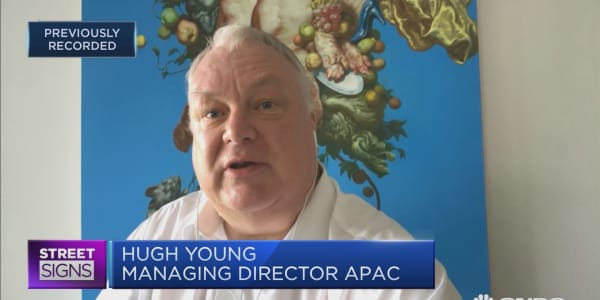When it comes to feeding the world, there are two big worries for authorities and aid agencies.
Conflicts and disasters in Africa and Syria and the emergency efforts to relieve hunger regularly make headlines. But the problem of people not getting proper access to food due to the twin problems of food loss through inefficient production and food waste – where developed nations throw away perfectly adequate food due to excess – is of much bigger concern.
According to the Food and Agriculture Organization (FAO) of the UN, the amount of food that is never consumed is as high in industrialized countries as it is in developing countries. However, in developing countries more than 40 percent of that total occurs at the production level. But in developed countries, an equal percentage is due to food that is simply thrown away by either retailers or consumers.
(Read more: Chart of the Day:The Google food shortage indicator)
According to the Food and Agriculture Organization (FAO) of the UN, the world wastes a staggering 1.3 billion tonnes of food per year.
"Food waste at consumer level in industrialized countries (222 million ton) is almost as high as the total net food production in sub-Saharan Africa (230 million ton)," the report concluded.
"Per capita, food wasted by consumers in Europe and North-America is 95-115 kg/year, while this figure in sub-Saharan Africa and South/Southeast Asia is only 6-11 kg/year."
Such a huge waste is taking a toll on the world's resources – and economy.
FAO Agro-Industry Officer Robert van Otterdijk told CNBC that there was a huge risk to the planet.
"Both food loss and waste reflect a huge waste of natural resources and may cause climate change," he said. "All this food has been produced, and it is wasted and not used. That is a great shame to the use of natural resources."
(Read more: World's richest have same wealth as 3.5 billion poorest)
The FAO's own research found that without accounting for greenhouse gas emissions from land use change, the carbon footprint of food produced and not eaten is estimated at 3.3 G tonnes of CO2 – making it the third top emitter of greenhouse gases after the U.S. and China.
"Food wastage reduction would not only avoid pressure on scarce natural resources but also decrease the need to raise food production by 60 percent in order to meet the 2050 population demand," the report stated.
Food loss due to the production process is down to financial, managerial and technical limitations in harvesting, storage, infrastructure, packaging and marketing. The FAO wants to solve this byencouraging small farmers to organize, diversify and upscale their production and marketing, along with investments in infrastructure, transportation, processing and packaging. The FAO along with the International Fund for Agricultural Development (IFAD) and the WFP recently launched a joint $2.7 million project funded by the Swiss Agency for Development Cooperation to target food losses in developing countries.
(Read more: Tesco admits towasting huge amount of food)
Food waste came into the spotlight last year when Tesco, the U.K.'s largest retailer by sales, hit the headlines after the company revealed that it generated 28,500 tons of food waste in the first six months of the year. The supermarket and not-for-profit company Waste and Resources Action Programme (WRAP) said that Tesco's waste problem was part of a much larger issue, with the company estimating that 15 million tons of food and drink were simply thrown away each year across the U.K.
Tesco, using its own data and industry-wide figures, also estimated that across the U.K. food industry as a whole, 68 percent of salad to be sold in bags was wasted, with 35 percent of it thrown out by customers.
It's not just the retailers but the consumers too who are throwing away their food. The consequences of this for the wider food market are not yet known, although van Otterdijk and the FAO are investigating the matter and will release findings later this year.
For Greg Barrow, who heads the WFP's liaison office in London, the main concern is evident. "What happens is that if a lot of food is being wasted and…what this does is it creates a situation where the food that is available is more expensive and less people are able to get it," he said."One could say that if the population grows at the rate it does and the world continues to waste as much food as it does, then ultimately somewhere down the line it could manifest itself in terms of a shortage."
The problem is how the Western world combats food waste. Barrow argued that while the FAO can attempt to change the production process in the developing world, it can only highlight the food waste issue with industrialized nations. "It's not like they're (the FAO) going to suddenly appear on the high street in London and tell people what to do in terms of buying one bag of salad as opposed to two," he said. "That's really for government policy makers to decide."
(Read more: The biggest global risks in 2014)
Howard Buffett, the son of the American business magnate, Warren, established the Howard G. Buffett Foundation (HGBF) in 1999 to improve the standard of living and quality of life for the world's most impoverished people. He agreed that food waste back in the U.S. and Europe was a key area of debate in the coming years.
"I get frustrated when I walk into a movie theatre and the first thing I see is that I can super-size my soda for $2. I don't want to!" he said exasperatedly. "That's going to become a bigger debate in this country about people's habits…I think it's a stretch to say that's going to have an effect on global food prices any time soon, but over time…it will have some impact, eventually."
—By CNBC's Kiran Moodley. Follow him on Twitter @kirancmoodley




